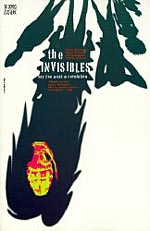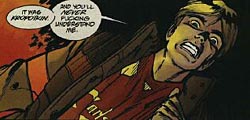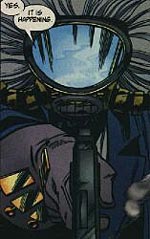>> The Friday Review: The Losers: Ante Up
>> The Friday Review: Marvels
More...

 Writer: Grant Morrison
Writer: Grant Morrison
Artists: Steve Yeowell, Jill Thompson and Dennis Cramer
Colourists: Daniel Vozzo with Electric Crayon
Letterer: Clem Robins
Publisher: DC Vertigo
Collecting THE INVISIBLES Vol. 1 #1-8
Price: $19.95
ISBN: 1563892677
Anger is an energy, but disobedience is power.
When THE INVISIBLES debuted in late 1994, I was seventeen, and in my final year of high school. Ergo, I was primed to get the most from Grant Morrison's sequential manifesto.
While I wasn't questioning authority to the extent Dane McGowan does in the early chapters of SAY YOU WANT A REVOLUTION, I was arguing with teachers and badgering my less-informed classmates on a frequent basis. So you could imagine how much I dug the title page of 'Dead Beatles' - McGowan letting fly with both invective and a Molotov cocktail. I was hooked.
McGowan is the readers' road in to the story - he's not an entirely sympathetic character, but we identify with his anger and his helplessness atbeing just another English teenage tearaway. Being made to feel useless at school and unwanted at home, he takes an act of rebellion too far, and is sentenced to Harmony House, a (supposed) reform school for wayward boys.
After being told that he will conform, like it or not, the stage is set for Dane's rescue at the hands of King Mob in suitably dramatic (and violent) fashion. Mob has the express intent of making Dane a member of his Invisibles cell - but only after a lengthy and disturbing initiation process.
 The twin attack of the first two stories collected here, 'Dead Beatles' and 'Down & Out in Heaven & Hell', lays the groundwork for Morrison's all-encompassing intent behind THE INVISIBLES. He's quoted on the back cover of REVOLUTION as saying, "it's the next stage in the evolution of what I want to do with comics," and there is ample evidence here to back up that claim. From his earliest beginnings at 2000AD, it was evident that Morrison wanted to push the proverbial envelope of comic book storytelling. If truth be told, I doubt I would've even glanced at THE INVISIBLES had I not been primed by Morrison's early collaboration with Steve Yeowell, ZENITH.
The twin attack of the first two stories collected here, 'Dead Beatles' and 'Down & Out in Heaven & Hell', lays the groundwork for Morrison's all-encompassing intent behind THE INVISIBLES. He's quoted on the back cover of REVOLUTION as saying, "it's the next stage in the evolution of what I want to do with comics," and there is ample evidence here to back up that claim. From his earliest beginnings at 2000AD, it was evident that Morrison wanted to push the proverbial envelope of comic book storytelling. If truth be told, I doubt I would've even glanced at THE INVISIBLES had I not been primed by Morrison's early collaboration with Steve Yeowell, ZENITH.
Albert Camus defined a rebel as "a [person] who says no," and THE INVISIBLES certainly has antecedents in the wider media that bear out that observation, from CATCHER IN THE RYE to PUMP UP THE VOLUME. Conversely, THE INVISIBLES could be seen (on a basic level) as a superhero team book, fully furnished with codenames and secret headquarters. From the Doom Patrol, to the Justice League, to his current take on the X-Men, Morrison has repeatedly demonstrated his knack for handling large and diverse casts.
It's not just the cast members, though, that Morrison is juggling like some demented carnival clown. From the secret nature of cities, to John Lennon as a latter-day deity; from a (literal) bird's eye view of the world, to (metaphorical) leaps of faith, Morrison works in competing and contrasting ideas, narrative modes and genres. 'Dead Beatles' works as a prologue-come-statement of intent, while 'Down & Out.' is elliptical and confronting. The third story in the book, 'Arcadia', which juxtaposes and entwines an intellectual debate between Byron and Shelley with the Invisibles travelling back in time to recruit the Marquis de Sade for their cause - engages on both a philosophical and visceral level.
 In all three of the tales contained in REVOLUTION, Morrison's dialogue is typically forceful and sanguine. Like mother's milk to a baby - which, in effect, THE INVISIBLES is - Morrison's words feed and suckle his most favoured and fevered brainchild.
In all three of the tales contained in REVOLUTION, Morrison's dialogue is typically forceful and sanguine. Like mother's milk to a baby - which, in effect, THE INVISIBLES is - Morrison's words feed and suckle his most favoured and fevered brainchild.
Steve Yeowell has always been a master of solid storytelling, and between 'Dead Beatles' and 'Down & Out', not a line is wasted, nor an opportunity lost to advance and make clear Morrison's nervous-twitch plotting. Morrison may refuse to sit still, but Yeowell exceeds at keeping up.
Sadly, Jill Thompson and Dennis Cramer let the side down with their more lacklustre contribution to 'Arcadia'. Thompson has been responsible for some excellent work in the past (as evidenced by THE SANDMAN: BRIEF LIVES), but Cramer's inks weigh down her linework like a gangster's concrete boots. Witness King Mob's gunfight with the Cyphermen; what should've been a graceful and balletic sequence is made to look stiff and uninvolving. Still, such is the drive behind Morrison's plot that Thompson and Cramer's art isn't the distraction it otherwise would be.
REVOLUTION as a package is also noteworthy, from Peter Milligan's epistolary introduction to Rian Hughes' minimalist pop-art design. It works as a whole, despite 'Arcadia' concluding on something of a cliffhanger. It's been said that REVOLUTION isn't the best place to start with THE INVISIBLES, despite it being the beginning of the saga. If you're like me, and prefer to get in on the ground floor, then hopefully this review may have convinced you - but if you were already simpatico with the Invisibles' worldview, then you can disregard this review and start wherever the hell you like. Morrison and his creations would doubtless encourage you to do so, too.
Anger is an energy, but disobedience is power.
And so we return and begin again.

This article is Ideological Freeware. The author grants permission for its reproduction and redistribution by private individuals on condition that the author and source of the article are clearly shown, no charge is made, and the whole article is reproduced intact, including this notice.


